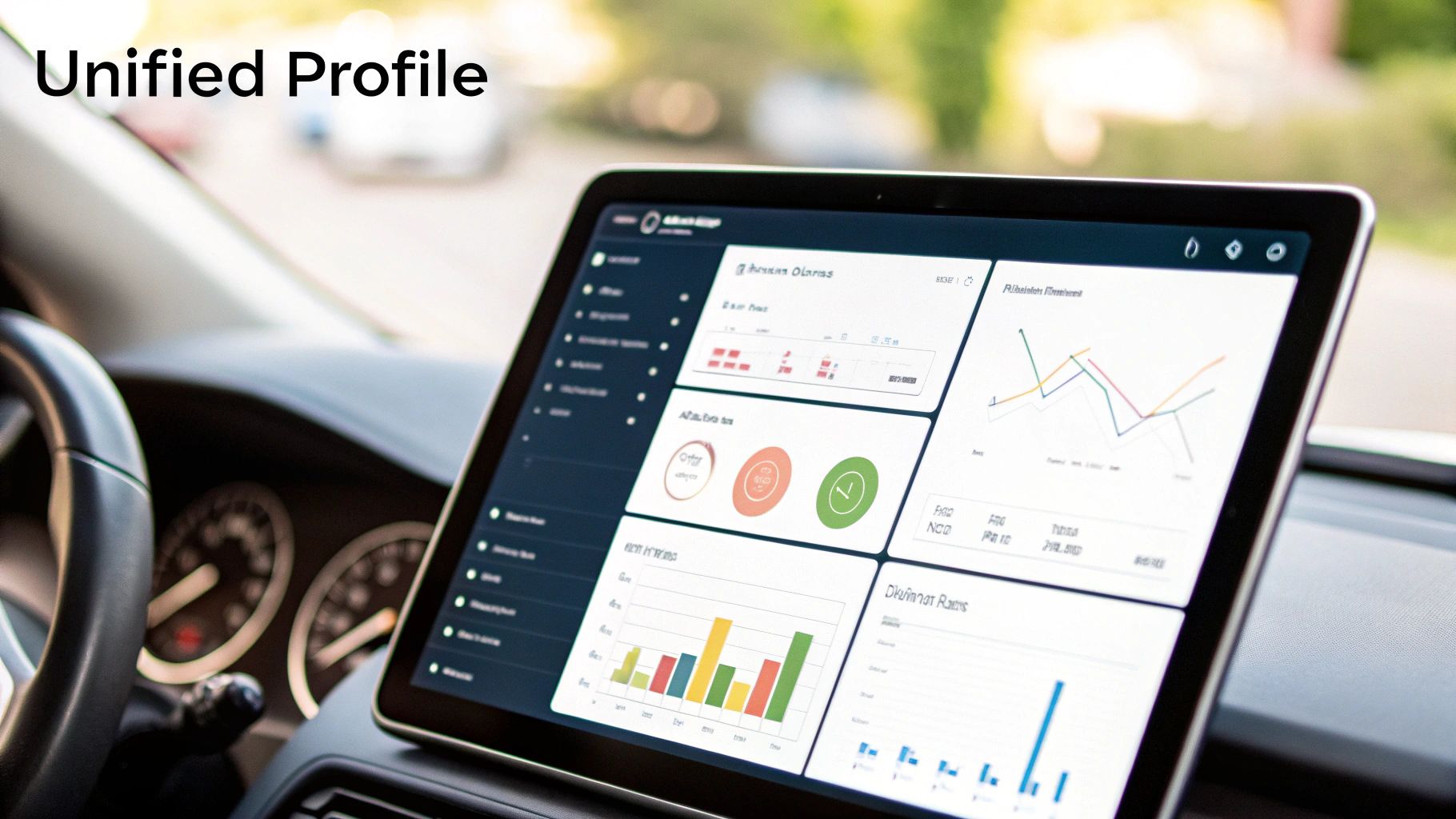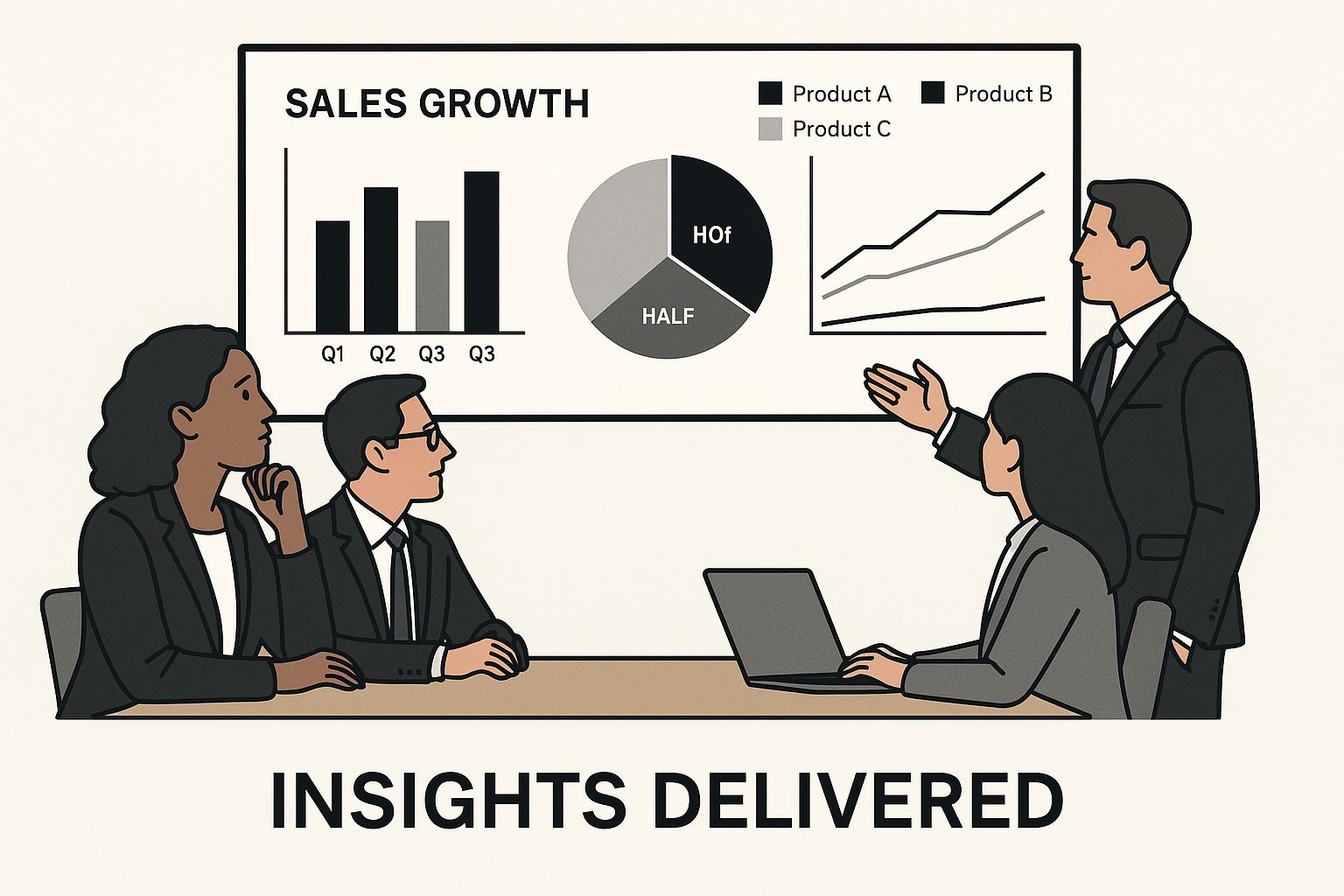The Unified Customer View: Why It's Your Missing CX Piece

Your teams are likely dealing with customer data spread across various platforms. Sales uses HubSpot to track interactions, support logs tickets in Jira, and product manages feedback. But when this information is siloed, it loses its value. A unified customer view (UCV) creates a single source of truth, connecting every customer interaction.
A UCV is more than just technology; it's the backbone of excellent customer experiences. Imagine your support team instantly seeing a customer's complete history—past purchases, open Jira tickets, and previous interactions—all within HubSpot. This empowers them to personalize support and resolve issues efficiently, boosting customer satisfaction.
Product teams also benefit significantly. By understanding the customer behind each feature request, they can make data-driven decisions about development priorities.
This interconnectedness is crucial in today's competitive landscape. A single bad experience can lead to over 50% of customers switching to competitors. Find more detailed statistics here. A UCV is vital for creating the seamless, personalized experiences that retain customers. Building this 360-degree view is key to thriving in your market. This is where strategically integrating HubSpot and Jira becomes essential.
Why a UCV Matters for HubSpot and Jira Users
For teams using both HubSpot and Jira, a fragmented customer view leads to real frustration. Support agents waste time switching between platforms, searching for information. Product teams struggle to connect feature requests with customer value, potentially misaligning development. RevOps leaders lack a complete view of customer health.
These disconnects have a significant impact. Longer resolution times, duplicated work, frustrated customers, and missed upsell opportunities are some of the consequences. A UCV, powered by a strong HubSpot-Jira integration, addresses these issues.
It transforms scattered data into a cohesive customer narrative, accessible to every team. This streamlined access to information isn't just about efficiency. It's about building stronger customer relationships, anticipating needs, and driving growth. In the following sections, we'll explore the challenges of disconnected data and how HubSpot for Jira provides a solution.
The High Cost of Disconnected Customer Data

This infographic shows a team analyzing performance metrics. It highlights how important clear data visualization is for making informed decisions. Connecting different data points helps businesses uncover valuable insights that guide strategic action. These insights are critical because disconnected customer data carries significant, measurable costs. It’s not just about lost efficiency, it’s about lost revenue and frustrated customers.
The Impact on Support Teams
Imagine a support agent assisting a premium client. This client has explained their issue multiple times across various channels. However, the agent can't see this history within Jira. They're forced to ask the same questions again, increasing resolution time and damaging the customer relationship. This illustrates how a lack of a unified customer view leads to longer resolution times and lower customer satisfaction.
Challenges for Product Development
Disconnected data also affects product teams. Consider a product manager prioritizing feature requests. Without understanding the customer value tied to each request, they’re working blindly. They might prioritize a feature from a few low-value customers over a vital request from a key account. This disconnect can cause misaligned product development and missed revenue growth.
RevOps Blind Spots
Revenue Operations (RevOps) leaders also struggle. Without a unified customer view, accurately gauging customer health is nearly impossible. Scattered data makes identifying at-risk accounts or expansion opportunities difficult. This lack of visibility hinders strategic decisions and impacts overall revenue. Identifying upsell opportunities becomes much harder without a complete picture of customer interactions.
Quantifying the Costs
These disconnects have real business costs. Longer resolution times mean higher support costs. Duplicated work wastes employee time. Frustrated customers churn. Missed upsell opportunities limit revenue potential. These are not minor inconveniences; they significantly impact the bottom line.
To understand the impact of disconnected data, let's examine a comparison of key business metrics:
The Cost of Disconnected Customer Data
This table compares key business metrics between organizations with and without a unified customer view.
| Metric | Without Unified View | With Unified View | Impact |
|---|---|---|---|
| Resolution Time | High | Low | Reduced support costs and improved customer satisfaction |
| Customer Churn | High | Low | Improved customer retention and increased lifetime value |
| Upsell/Cross-sell Rate | Low | High | Increased revenue generation and improved customer lifetime value |
| Product Development Efficiency | Low | High | Better product-market fit and faster time to market |
| RevOps Effectiveness | Low | High | Improved forecasting accuracy and more efficient resource allocation |
As this table demonstrates, a unified customer view significantly improves several key business metrics. This leads to tangible benefits like lower costs, higher revenue, and greater customer satisfaction.
The increasing investment in Customer Data Platforms (CDPs) emphasizes the need for a unified customer view. The global CDP market was worth approximately $5.72 billion in 2024 and is projected to reach $7.39 billion in 2025, a 29.2% CAGR. Discover more insights about CDPs. Integrating solutions like HubSpot and Jira provides a clear way to reduce these costs and boost business growth.
Building Your Unified Customer View: HubSpot Meets Jira

Disconnected customer data presents significant challenges for many businesses. The HubSpot for Jira app offers a solution, bridging the gap between your HubSpot CRM and Jira instances. This integration helps build a powerful unified customer view, facilitating a seamless flow of information and changing how teams interact with customer data.
Two-Way Synchronization: The Heart of the Solution
The core of the HubSpot for Jira app is its two-way field synchronization. Changes in either HubSpot or Jira are automatically reflected in the other system. Updating a contact's email address in HubSpot, for example, instantly updates the corresponding Jira issue.
This ensures data consistency and eliminates manual updates, reducing errors and saving time and resources. Data silos often lead to a fragmented customer picture. For more insights on improving data sharing and teamwork, check out this article on Cross-Functional Collaboration.
Bringing HubSpot into Jira: A Practical Look
HubSpot for Jira embeds key HubSpot objects—Contacts, Companies, Deals, and Tickets—directly into Jira issues. This provides valuable context for development and support teams.
Consider a developer working on a bug fix. With this integration, they can instantly see the affected customer's company, deal stage, and related support tickets, all within Jira. This context allows for better prioritization based on customer value and impact.
Automating Ticket Creation: Closing the Loop
The integration goes beyond simply displaying information. You can configure automated ticket creation in Jira based on HubSpot events. For example, a high-value customer submitting a support request through HubSpot could automatically trigger a Jira issue, assigned to the appropriate team. This streamlines workflows and ensures critical customer requests are addressed.
Key Features for a Unified Experience
Here are some key features of the HubSpot for Jira app that contribute to a unified customer experience:
- Contact/Company Panel: A detailed view of the customer associated with a Jira issue.
- Comment Mirroring: Comments made in HubSpot appear in Jira, and vice versa, improving communication.
- Two-Way Field Sync: Ensures data consistency between both systems.
- Automatic Ticket Creation: Streamlines responses to customer requests.
A Simple Implementation Guide
Setting up the HubSpot for Jira integration is simple:
- Install the app from the Atlassian Marketplace.
- Connect your HubSpot and Jira accounts.
- Configure field mappings to synchronize data.
- Set up automation rules for ticket creation.
- Customize the contact/company panel.
- Train your teams on the new workflow.
Following these steps establishes a unified customer view, empowering teams and enhancing the customer experience. This connection enables faster issue resolution and a more proactive support approach. Using these features strategically allows organizations to break down silos and improve collaboration.
Unified Customer View in Action: A Success Story
Metrics and features are informative, but real-world examples are often more compelling. Let's explore how Greenfield Tech, a B2B software provider, improved their customer experience using the HubSpot integration for Jira. When connecting tools like these, a well-structured system in Notion can be a great foundation. This Notion to blog conversion guide offers helpful tips for setting this up.
Before: A Disconnected Story
Before integrating their systems, Greenfield Tech faced challenges with data silos. Support agents spent excessive time searching for customer information across different platforms. Developers lacked important context when addressing issues. Key clients felt frustrated having to repeatedly provide the same information. This fragmented approach resulted in slower resolution times and lower customer satisfaction.
After: A Unified Transformation
Integrating HubSpot with Jira significantly changed Greenfield Tech's operations. They achieved a 40% reduction in issue resolution time and a 28% increase in customer satisfaction scores. Visibility into feature requests from their most valuable accounts also improved dramatically. These improvements resulted from more efficient workflows and better collaboration.
Automating for Enterprise Clients
A key workflow improvement was the automated creation of Jira issues for enterprise client requests. When a high-value customer submitted a request in HubSpot, a corresponding Jira issue was automatically generated and assigned to the appropriate team. This eliminated manual handoffs and guaranteed timely responses, a vital element for enterprise customer success.
Empowering Developers with Context
Another important change was providing developers with direct access to customer history within Jira. This eliminated the need to switch between platforms. Developers gained access to a customer's complete HubSpot profile – including past interactions, purchases, and open support tickets – directly within Jira. This streamlined their work and allowed them to consider customer value when prioritizing tasks.
A Tangible Impact
The positive effects of the HubSpot for Jira integration on Greenfield Tech were clear. Faster resolution times, increased customer satisfaction, and improved visibility into high-value accounts all contributed to noticeable business growth. This example demonstrates the value of a unified customer view. It highlights how connecting data can improve the customer experience and generate positive business outcomes. This goes beyond simply linking data; it's about fostering stronger customer relationships. By uniting teams around a single source of truth, you create a more cohesive and responsive customer journey, ultimately leading to greater customer loyalty and increased revenue.
Maximizing Your Unified Customer View: Expert Strategies
Having a unified customer view is the first step. The real power comes from actively using it. This section offers practical advice for organizations at any point in their HubSpot–Jira integration. We'll explore how to use this unified view for better efficiency, collaboration, and a superior customer experience.
Mapping Critical Data Fields: The Foundation of a Strong UCV
A strong unified customer view (UCV) depends on effective data mapping. This means carefully selecting which customer data fields from HubSpot sync with Jira. Consider what information your support and product teams need most when addressing customer issues.
For example, syncing a customer's subscription tier, product usage, or even their customer satisfaction score adds valuable context within Jira. This focused approach gives teams the right information, without overwhelming them. HubSpot for Jira lets you configure these field mappings to meet your exact needs.
Prioritizing Issues Based on Customer Value: A Strategic Advantage
A unified view lets you prioritize issues strategically based on customer value. Imagine a high-value customer reports a bug. With HubSpot data in Jira, support agents can instantly flag this as high-priority for a quick response.
This data-driven approach helps allocate resources effectively, focusing on your most valuable customers. This boosts customer satisfaction and protects revenue.
Automation for Efficiency: Triggering the Right Actions
Automation maximizes the value of your unified customer view. Set up automation rules that trigger actions in either HubSpot or Jira based on changes in the other system. For example, if a customer churns in HubSpot, an automation rule could automatically close related open Jira issues, saving your team time.
Advanced Strategies: Taking Your UCV to the Next Level
Leading teams further enhance their UCV with advanced strategies:
-
Custom Fields: Use custom fields in HubSpot and Jira to track key metrics like customer health scores for a consistent view.
-
Tagging Taxonomies: Create tagging taxonomies that work across both platforms to organize and filter customer data.
-
Reporting Dashboards: Design dashboards that combine data from HubSpot and Jira for powerful customer insights.
For example, a dashboard showing the average resolution time for Jira issues by customer segment can reveal areas to improve your support process. Using these strategies and the HubSpot for Jira app from resolution transforms your customer data into a powerful tool for business growth.
Before implementing a UCV, consider using the checklist below to guide you through the process.
Introducing the "Unified Customer View Implementation Checklist," a guide for successfully implementing and maintaining a UCV with HubSpot and Jira.
| Step | Owner | Timeline | Success Criteria |
|---|---|---|---|
| Define Key Data Fields | Product & Support Teams | Week 1 | Agreement on essential data points |
| Configure Field Mappings in HubSpot for Jira | System Administrator | Week 2 | Successful data synchronization tested |
| Establish Prioritization Rules | Support Lead | Week 3 | Clear guidelines for issue prioritization |
| Implement Automation Rules | System Administrator | Week 4 | Automated actions triggered correctly |
| Create Custom Fields and Tags | Product Team | Week 5 | Consistent tracking across both platforms |
| Design Reporting Dashboards | Data Analyst | Week 6 | Actionable insights derived from dashboards |
This checklist provides a framework for a structured UCV implementation. By following these steps, teams can effectively leverage the combined power of HubSpot and Jira for improved customer management. These best practices empower teams to be more proactive, personalized, and effective in managing customer relationships.
Your Unified Customer View Questions, Answered
Integrating HubSpot and Jira can feel like a big undertaking. This section addresses common questions teams have about creating a unified customer view with the HubSpot for Jira integration. We'll tackle the practical concerns decision-makers face, providing clear, straightforward answers.
Data Security and Customization
-
How does the HubSpot for Jira integration handle sensitive customer information? Security is paramount. The integration adheres to strict data privacy regulations, ensuring your customer data is protected during transfer and storage. Permission-based access controls within the app let you manage which teams see specific data.
-
Can we customize which customer fields sync between HubSpot and Jira? Absolutely. You control which fields sync, choosing the data most relevant to your teams. This flexibility allows you to tailor the integration to your specific needs, whether it's syncing deal stages, support ticket statuses, or custom properties. This provides your support and development teams with targeted data, avoiding information overload.
Implementation and Scalability
-
What's the typical implementation timeline, and how much technical expertise is required? The HubSpot for Jira integration is designed for ease of use. Installation is streamlined through the Atlassian Marketplace, typically requiring minimal technical expertise. Setup involves connecting your accounts, configuring field mappings, and setting up automation rules, all achievable quickly with our helpful documentation and support.
-
How does the solution scale as our customer base grows? The integration is built to scale seamlessly with your business. Whether you have hundreds or thousands of customers, the two-way synchronization and automated workflows ensure data consistency and efficient collaboration across teams of any size.
For more detailed information and to get started building your unified customer view, visit the HubSpot for Jira app on the Atlassian Marketplace. Try it free and discover the power of connected customer data.
